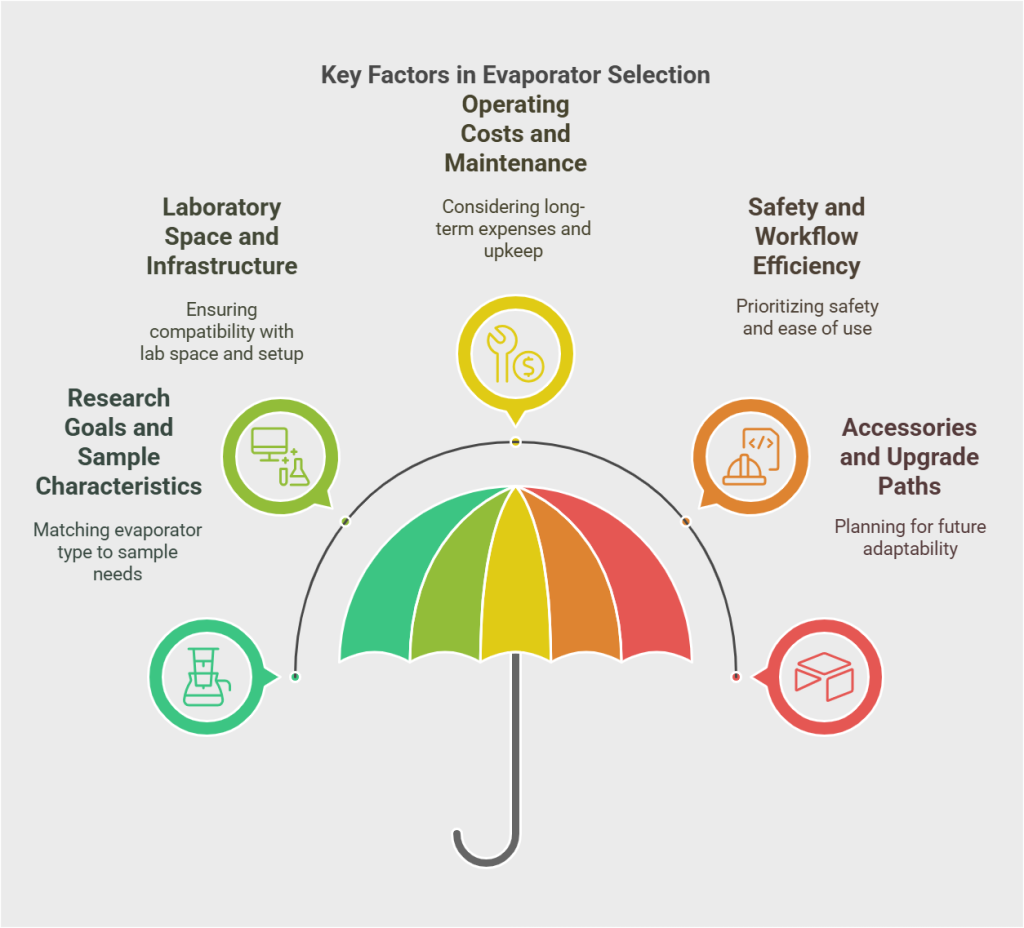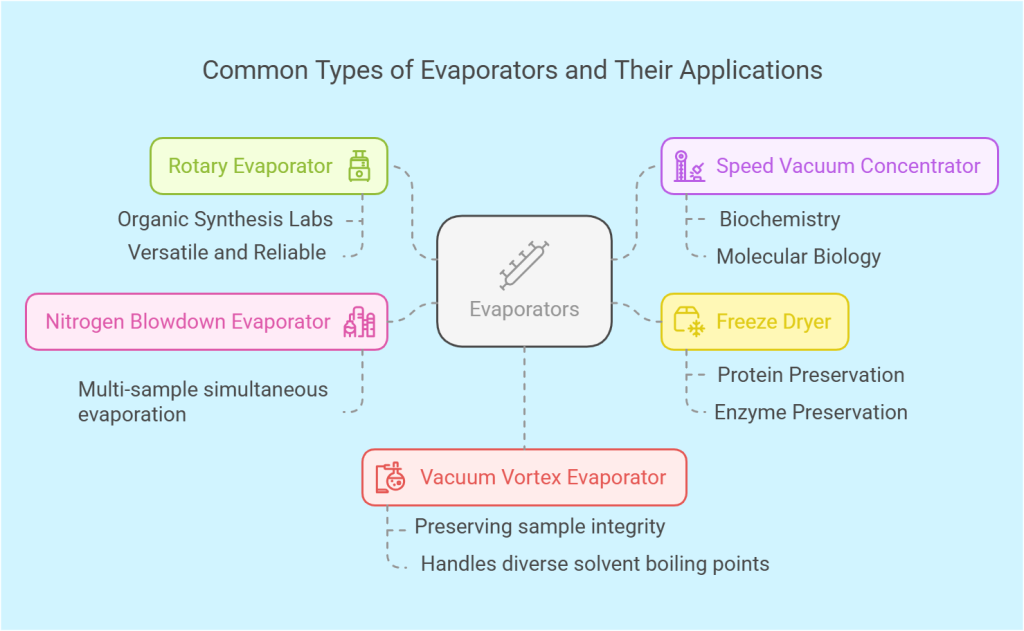A Comprehensive Guide to Laboratory Evaporators and Their Price Ranges
 A Comprehensive Guide to Laboratory Evaporators and Their Price Ranges
A Comprehensive Guide to Laboratory Evaporators and Their Price Ranges
Efficiently removing solvents to concentrate or dry samples is a crucial step in many research workflows. By speeding up and simplifying this process, laboratory evaporators significantly enhance overall experimental efficiency. However, because there are many types of evaporators available—each with its own unique features, applications, and price ranges—selecting the right model can be challenging. In this article, we will examine the main types of evaporators commonly used in research settings, explore their approximate price ranges, and outline key points to keep in mind when choosing the best equipment for your lab. If you are a scientist looking to streamline your solvent removal process, read on to discover the ideal solution for your needs.
<Index>
1. Understanding the Role of Laboratory Evaporators and Their Basic Types
1-1. What Is a Laboratory Evaporator?
1-2. Common Types of Evaporators
2. Key Evaporator Types and Their Typical Price Ranges
2-1. Rotary Evaporators
2-2. Speed Vacuum Concentrators
2-3. Freeze Dryers (Lyophilizers)
2-4. Nitrogen Blowdown Evaporators
2-5. Vacuum Vortex Evaporators (e.g., Smart Evaporator™)
3. Essential Considerations When Selecting an Evaporator
3-1. Research Goals and Sample Characteristics
3-2. Available Laboratory Space and Infrastructure
3-3. Operating Costs and Maintenance
3-4. Safety and Workflow Efficiency
3-5. Accessories and Upgrade Paths
1: Understanding the Role of Laboratory Evaporators and Their Basic Types
1-1. What Is a Laboratory Evaporator?
A laboratory evaporator is a device designed to remove solvents from samples by applying heat, vacuum, or gas flow—often in combination. This process is essential for:
- Sample concentration: Increasing the concentration of target compounds by evaporating excess solvent.
- Solvent exchange: Replacing one solvent with another more suitable for subsequent steps.
- Sample drying: Fully removing solvent to obtain a dry residue for further analysis or experimentation.
Because solvent removal can be time-consuming, an effective evaporator is vital for boosting throughput and ensuring reproducible experimental results.
1-2. Common Types of Evaporators
・Rotary Evaporator (Rotavap)
Perhaps the most widely recognized type of evaporator, a rotary evaporator uses a rotating flask under reduced pressure to gently remove solvents. It is a staple in organic synthesis labs for post-reaction solvent removal and is known for its versatility and reliability.
・Speed Vacuum Concentrator (SpeedVac)
Often referred to simply as a “SpeedVac,” this type of evaporator combines centrifugal force and vacuum to remove solvents at relatively low temperatures. It is especially useful in biochemistry and molecular biology, where delicate samples require gentle handling.
・Freeze Dryer (Lyophilizer)
Freeze drying involves first freezing a sample, then reducing the surrounding pressure so the frozen solvent sublimates directly from solid to gas. This is an excellent method for preserving the activity of heat-sensitive compounds such as proteins or enzymes, though it can be slower and require more space than other methods.
・Nitrogen Blowdown Evaporator (N₂ Blow)
This system directs a stream of nitrogen gas onto the sample’s surface to evaporate the solvent. It is useful for processing multiple samples simultaneously, although special precautions may be necessary to manage solvent vapors and ensure operator safety.
・Vacuum Vortex Evaporator (e.g., Smart Evaporator™)
By combining vacuum and a vortex or swirling motion, these evaporators efficiently remove solvent with minimal sample splashing. This design is particularly beneficial for maintaining sample integrity and handling solvents with varying boiling points.
2. Key Evaporator Types and Their Typical Price Ranges
Below is a general overview of each type of evaporator, including approximate costs and representative brands. Actual prices may vary based on factors like optional features, local distributors, or currency fluctuations.
2-1. Rotary Evaporators
- Representative Brands: BUCHI, Heidolph, Yamato
- Price Range: Approximately USD 3,000–15,000 (JPY 300,000–1,500,000)
- Basic models: ~USD 3,000–6,000
- High-end units (with automation or large flask compatibility): ~USD 6,000–15,000
- Key Features:
- Standard choice for most organic synthesis and general lab settings
- Wide selection of accessories (condenser types, flasks, seals)
- Variable sizes for both academic and industrial scales
2-2. Speed Vacuum Concentrators
- Representative Brands: Thermo Fisher Scientific (SpeedVac), Labconco
- Price Range: Approximately USD 10,000–30,000 (JPY 1,000,000–3,000,000)
- Compact models: ~USD 10,000–15,000
- Large, multi-sample models: ~USD 15,000–30,000
- Key Features:
- Combined centrifugal force and vacuum for gentle solvent removal
- Ideal for heat-sensitive samples and biomolecules
- Compatible with both aqueous and organic solvents
2-3. Freeze Dryers (Lyophilizers)
- Representative Brands: Labconco, Millrock Technology
- Price Range: Approximately USD 15,000–50,000 (JPY 1,500,000–5,000,000)
- Benchtop units: ~USD 15,000–25,000
- Large-scale freeze dryers: ~USD 25,000–50,000+
- Key Features:
- Preserves structural integrity of proteins, enzymes, and other sensitive materials
- Slower process but essential for maintaining sample quality
- Requires adequate space, vacuum pumps, and low temperatures
2-4. Nitrogen Blowdown Evaporators
- Representative Brands: Organomation, Porvair Sciences
- Price Range: Approximately USD 5,000–15,000 (JPY 500,000–1,500,000)
- Basic models: ~USD 5,000–8,000
- Advanced multi-sample systems: ~USD 8,000–15,000
- Key Features:
- Efficient for processing multiple samples simultaneously
- Compatible with various organic solvents
- Must handle solvent vapors carefully (fume hoods or dedicated enclosures)
2-5. Vacuum Vortex Evaporators (e.g., Smart Evaporator™)
- Representative Brands: BioChromato (Smart Evaporator™), others
- Price Range: Approximately USD 10,000–30,000 (JPY 1,000,000–3,000,000)
- Single-position models: ~USD 10,000–15,000
- Multi-position units: ~USD 20,000–30,000
- Key Features:
- Combines vacuum with vortex or swirling motion for controlled solvent removal
- Minimizes sample splashing and foaming
- Accommodates a range of sample volumes and solvent types
| Evaporator Type | Representative Brands | Price Range (USD) | Key Features |
|---|---|---|---|
| Rotary Evaporators | BUCHI, Heidolph, Yamato | 3,000–15,000 | Standard for organic synthesis, various accessories available, scalable sizes |
| Speed Vacuum Concentrators | Thermo Fisher Scientific (SpeedVac), Labconco | 10,000–30,000 | Centrifugal force + vacuum, gentle solvent removal, ideal for biomolecules |
| Freeze Dryers (Lyophilizers) | Labconco, Millrock Technology | 15,000–50,000 | Preserves sample integrity, requires space, slow process |
| Nitrogen Blowdown Evaporators | Organomation, Porvair Sciences | 5,000–15,000 | Efficient for multiple samples, requires careful vapor handling |
| Vacuum Vortex Evaporators | BioChromato (Smart Evaporator™), others | 10,000–30,000 | Combines vacuum with vortex, minimal splashing, versatile sample handling |
Interested in the Smart Evaporator™? Click below to download a free White Paper.
3. Essential Considerations When Selecting an Evaporator
3-1. Research Goals and Sample Characteristics
Begin by clarifying what type of solvents and samples you will be handling. For heat-sensitive biological materials, Speed Vacuum Concentrators or Freeze Dryers often perform best. For rapid and routine solvent evaporation in organic synthesis, a Rotary Evaporator is typically the go-to choice. Matching the evaporator’s capabilities to your specific needs will help ensure consistent, reproducible results.
3-2. Available Laboratory Space and Infrastructure
Evaporators such as large freeze dryers or multi-sample SpeedVacs may require considerable floor or bench space, along with specific electrical or cooling requirements. Before purchasing, confirm that your lab can accommodate the system’s dimensions, weight, and any associated vacuum pumps or chillers. If space is limited, consider more compact models or specialized solutions like vacuum vortex evaporators.
3-3. Operating Costs and Maintenance
Beyond the initial purchase price, keep in mind the ongoing expenses for maintenance, consumables, and potential repairs. For instance, some vacuum pumps require regular oil changes, and certain freeze dryers may need periodic refrigeration servicing. Select a vendor or manufacturer with a reliable support network to ensure minimal downtime and consistent performance.
3-4. Safety and Workflow Efficiency
Solvent evaporation can involve flammable or toxic chemicals, making safety features a priority. Look for systems with secure enclosures, robust vacuum seals, and proper exhaust or venting solutions. Additionally, user-friendly features such as automated control panels, digital vacuum settings, or multi-sample programming can help streamline daily workflows and minimize errors.
3-5. Accessories and Upgrade Paths
Because research needs evolve over time, it is wise to invest in an evaporator that offers a range of compatible accessories—whether that means additional rotors, flask sizes, or specialized sample holders. This flexibility will help your lab adapt to future projects without requiring a completely new system.

4. Conclusion
Whether you need to concentrate samples, perform solvent exchanges, or fully dry sensitive biological materials, a laboratory evaporator is an indispensable tool. Rotary Evaporators, Speed Vacuum Concentrators, Freeze Dryers, Nitrogen Blowdown Evaporators, and Vacuum Vortex Evaporators each have distinct advantages and price points. When deciding on the best option, consider your experimental goals, sample characteristics, lab space, budget, and maintenance requirements. By selecting the right evaporator and keeping it well-maintained, you can significantly enhance workflow efficiency and consistently achieve high-quality research results.
We hope this comprehensive overview helps you navigate the landscape of laboratory evaporators and make an informed decision. With the right system in place, you will be well on your way to faster, more efficient solvent removal and better overall productivity in the lab.
Interested in the Smart Evaporator™? Click below to download a free White Paper.

 A Comprehensive Guide to Laboratory Evaporators and Their Price Ranges
A Comprehensive Guide to Laboratory Evaporators and Their Price Ranges